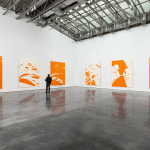
Contributed by Michael Brennan / “Fold Upon Fold,” the title of Hank Ehrenfried’s first solo exhibition in New York, at Auxier Kline on the Lower East Side, is an expression borrowed from a sonnet by French Symbolist Stéphane Mallarmé. It succinctly describes the creative premise behind every painting presented. Working in the trompe l’oeil style, Ehrenfried paints realistic images of his own collages, made mostly during the pandemic. Making the collages the subject of the paintings lends the show a lightly but distinctly meta character, reflecting both the claustrophobic intensity and the intellectual expansiveness of his endeavor.

The collages are made up of all manner of studio collectanea – photographs, drawings, reproductions of other artists’ work. Their subjects include snippets of grand interiors, horses, hunting dogs, male models posing for life drawing, and more. An aristocratic air abounds. These are the sorts of printed images, like a postcard of a favorite John Singer Sargent painting, that artists typically pin to their studio walls as sources of inspiration rather than direct quotation.


Ehrenfried is highly adept at the trompe l’oeil technique. He often squeezes his ephemera together accordion-style, rendering them complex compressions of his suspended contemporary life and frustrated musings. He reproduces them faithfully, but often there has been so much folding, cropping, and adjustment that the figurative elements can seem effectively abstract, legible but difficult to deconstruct. This quality makes his paintings tight without being uptight.


The paintings recall the famous trompe l’oeil still-lives of William Harnett and John F. Peto, 19th-century American masters of the style, but with key differences. Trompe l’oeil, like Precisionism, has sometimes been unfairly associated with stylistic and personal repression. Ehrenfried’s paintings may be exacting, but, in their celebration of aesthetic beauty and abundance of eroticism, they are surely not repressed. And, leaving aside content, he paints with a dashing flair that is liberating. His open, breezy paint-handling, exemplified by Daffodils, seems closer to late Manet – say, Flowers in a Crystal Vase – than to Harnett and Peto.



When representing photographs with paint has come to verge on cliché, Ehrenfried paints them with a freshness that does justice to both mediums. Beyond that, he inventively treats the still-life as a form of self-portraiture, and playfully dodges putative tensions among painting, drawing, collage, and photography. Perhaps coincidentally but not inappropriately, Ehrenfried’s collaged source material includes references to Cubism and early Picasso – the intersection explored in “Cubism and the Trompe l’Oeil Tradition,” which opens at the Metropolitan Museum of Art this October. Ehrenfried has successfully rehabilitated traditional painting tropes, combining illusion with allusion to reveal personal truths in a compelling 21st-century fashion.
“Hank Ehrenfried: Fold Upon Fold,” Auxier Kline, 19 Monroe Street, New York, NY. Through October 1, 2022.
About the Author: Michael Brennan is a Brooklyn-based painter who writes about art.






















